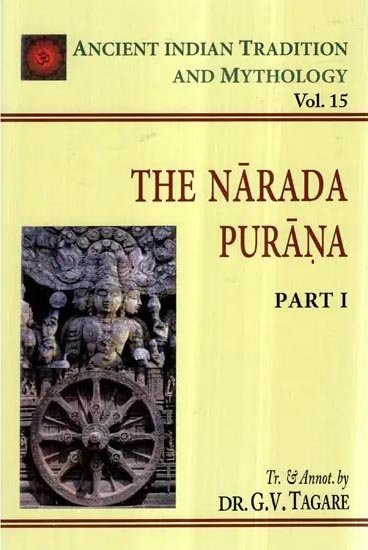Narada Purana (English translation)
by G. V. Tagare | 1950 | 14,468 words | ISBN-10: 8120803477 | ISBN-13: 9788120803473
This page describes The Narada Purana and the Mahapuranas of the English translation of the Narada Purana—an ancient Sanskrit text within Hindu literature categorized as one of the eighteen Mahapuranas. It explores various aspects of cosmology, ethics, and rituals, compiling rich narratives that emphasize devotion to Vishnu and the concepts of Dharma (righteousness) and Bhakti (devotion). The Narada Purana also addresses Tantric practices, philosophical discourses on Yoga and self-realization.
Go directly to: Footnotes.
10. The Nārada Purāṇa and the Mahāpurāṇas
Nārada Purāṇa chapters 92-109, are very important, as they give some idea about the contents of the Mahāpurāṇas before the final redaction of the Nārada Purāṇa (in the 10th cent. a.d.). As the annotations to the above chapters show, the contents and divisions in the present published Purāṇas are different from those given in the Nārada Purāṇa The extant Purāṇas differ from the Nārada Purāṇa in the following respects:
1. The total number of verses recorded in the Nārada Purāṇa and the actual number of verses in the extant Mahāpurāṇas. For example the Nārada Purāṇa (and Agni Purāṇa Brv. Vāyu, and Bhāgavata Purāṇa itself) gives 18000 as the total number of verses in the Bhāgavata Purāṇa but actually the Gītā Press edition of the Bhāgavata Purāṇa contains 14,579 verses.[1]
2. The nomenclature of different parts of the Purāṇas as given in the Nārada Purāṇa is different in their extant versions. For example, the Vāyu Purāṇa states (in 103.44) that it has the following four Pādas (sections) (1) Prakriyā (2) Anuṣaṅga (3) Upodghāta and (4) Upasaṃhāra and calls itself a four-footed Purāṇa. But the Nārada Purāṇa gives Pūrvabhāga and Uttarabhāga as the divisions of the Vāyu (vide Nārada Purāṇa.I.95.7).
3. The details of contents given in the Nārada Purāṇa and those found in the extant Purāṇas are different. There are both additions and deletions. For example, Nārada Purāṇa I.92.34 mentions the story of Rāma in the contents of the Br.P. but it is not found in the printed (G.M.) edition of the same. So also Nārada Purāṇa I. 95.7-15 mentions the Revā Māhātmya in the Vāyu but the printed texts (both Anandashram and Guru Mandal editions) do not give these chapters.[2] A number of such differences show that the texts of Purāṇas available to the author of the Nārada Purāṇa were different than those in the extant Purāṇas. But all the additions to the extant versions of the Purāṇas (as compared with the Nārada Purāṇa) need not be considered ‘spurious’ simply because it is not mentioned in the Nārada Purāṇa It is the MSS-evidence which is more important in deciding the genuineness of certain verses or portions of a Purāṇa rather than its inclusion or exclusion in the Nārada Purāṇa NP. Part II is definitely a later interpolation and ‘spurious’ even though the last redactor of the Nārada Purāṇa interpolated a few verses (Nārada Purāṇa 1. 97.11-18) to legitimise Nārada Purāṇa Part II.[3]
Footnotes and references:
[1]:
For other such differences vide NP. Part IV annotations. Nos. 13, 28, 17 etc.
[2]:
Also Revā Khaṇḍa of 232 chs. and caturaśīti-liṅga-Māhātmya 84 chapters in the Skanda Purāṇa, Lalitā Episode of 40 chs. in Brahmāṇḍa Purāṇa are not mentioned in the Nārada Purāṇa
[3]:
The differences between the contents of extant Purāṇas and those recorded in the Nārada Purāṇa are discussed in the annotations of chs. 92-109.
